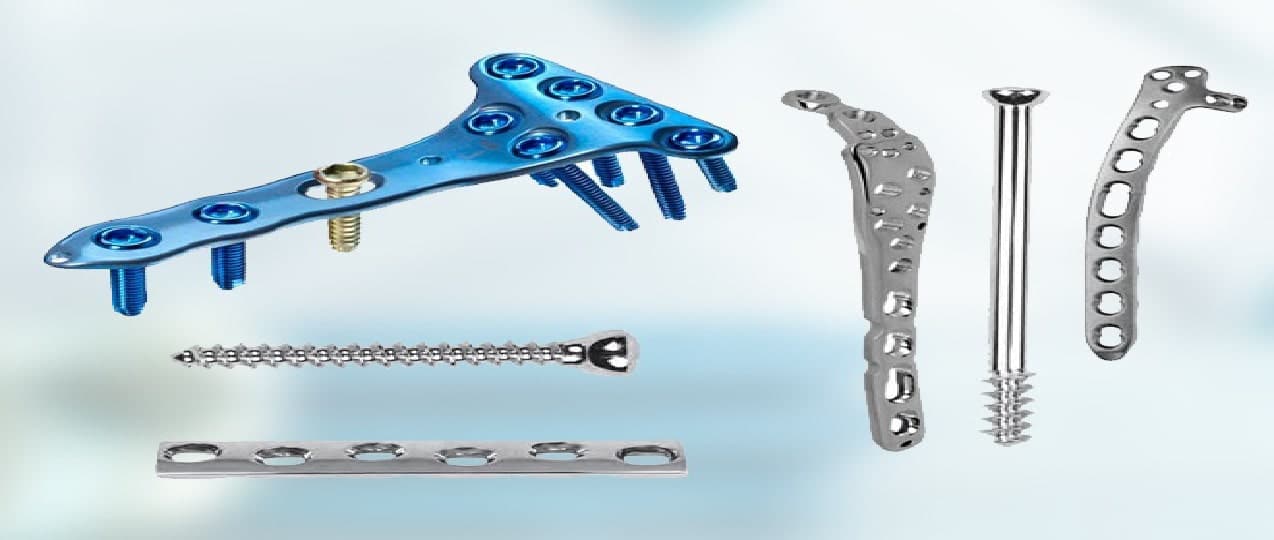India's #1 Top Orthopedic Implants Manufacturer Company
Orthopedic implants are medical devices that replace or support damaged bones or joints. They are commonly used in surgical procedures to repair fractures or correct deformities. Orthopedic implants are fabricated from various materials, including metal, ceramic, and plastic. The type of implant used depends on the location and severity of the injury or condition being treated. HCM Orthocare is a leading manufacturer, supplier, and exporter of orthopedic implants. Our products are designed with the latest technology. They are made from high-quality raw materials to ensure durability and long-lasting performance for a wide range of implants, including plates, screws, and nails, for various bone and joint injuries.
ORTHOPEDIC IMPLANTS MANUFACTURER
As a leading orthopedic implants manufacturer, HCM Orthocare is committed to providing innovative solutions to surgeons and patients as they have a team of experienced professionals who work tirelessly to develop new implant products that meet the evolving needs of the healthcare industry. Our manufacturing facilities are equipped with state-of-the-art machinery and quality control measures to ensure that every product meets the highest standards of national as well as global. Orthopedic implants are medical devices that maintain and restore the function of the musculoskeletal system, particularly in situations of injury, disease, or degeneration. These implants are often used in orthopedic procedures to replace damaged or diseased joints, including hips, knees, and shoulders, stabilize fractures, and correct abnormalities. They are often constructed of biocompatible materials, such as titanium, stainless steel, or cobalt-chromium alloys, for strength, longevity, and compatibility with the human body. The size, shape, and design of orthopedic implants vary based on the exact anatomical location being addressed and the individual demands of the patient. They play an important role in increasing mobility, reducing pain, and improving the overall quality of life of people with orthopedic problems.

ORTHOPEDIC IMPLANTS SUPPLIER
HCM Orthocare is a reliable and trusted orthopedic implants supplier as we have a global network of distributors who work closely with surgeons and hospitals to provide the best possible care for patients. We also offer a wide range of products at competitive prices and are committed to delivering on time and in full. Our customer service team is available 24/7 to assist with any questions or concerns related to orthopedic implants.
ORTHOPEDIC IMPLANTS EXPORTER
As an orthopedic implants exporter, HCM Orthocare has a strong presence in the international market. We have established partnerships with distributors and healthcare organizations in various countries, and our products are widely used in surgeries worldwide while complying with all international regulations and standards and ensuring that our products are safe and effective for patients. We also offer customized solutions for orthopedic implants to meet the specific needs of each market we serve.
WHAT DO ORTHOPEDIC IMPLANTS ENTAIL?
Orthopedic implants are specialized medical devices made to support or replace the human body’s bone and joint components that have been damaged or degenerated. These implants are frequently used in orthopedic procedures to help people with musculoskeletal disorders including arthritis, fractures, or joint degeneration regain their mobility, manage their pain, and live better overall. Orthopedic implants can include prosthetic joints (such as hip, knee, and shoulder replacements), bone plates, screws, and rods. To ensure durability and compatibility with the body, these implants are often created from materials like titanium or stainless steel. The successful provision of long-term comfort and functionality to patients with orthopedic difficulties depends heavily on the correct design and material selection of these implants. However, the advantages might outweigh the dangers. For example, without an implant or prosthetic, a patient could be forced to use a wheelchair even if it would still be quite possible for them to walk again.
Let’s now discuss several orthopedic implant types and their applications.
- Screws
Orthopedic screws in particular are essential in orthopedic procedures and the treatment of fractures. Stainless steel and titanium, which are high-quality materials renowned for their biocompatibility and robustness, are frequently used to create these screws. Orthopedic screws aid in the natural regeneration and alignment of the bone by stabilizing broken or damaged bones during the healing process. These specialized screws are available in a variety of sizes and forms, including cancellous screws for softer bone and cortical screws for dense bone. They are essential for stabilizing bone fractures, securing bone fragments, and strengthening the skeletal system, which helps patients regain mobility and experience less discomfort. They come in various forms and sizes; for instance, a reduction screw could have a thickness of 4.5 to 8.5 mm. - Plate
To stabilize broken bones and aid in their correct healing, orthopedic implants, also known as plates, are crucial tools used in orthopedic procedures. These plates normally come in a variety of sizes and shapes to accommodate various anatomical regions and fracture patterns. They are typically built from biocompatible materials like titanium or stainless steel. Orthopedic plates are placed carefully next to broken bones and fastened with screws to offer stability, alignment, and support while the bone heals. They are essential in facilitating the body’s normal bone regeneration process and guaranteeing that the shattered bone stays in the right place. In orthopedic surgery, plates are essential instruments that assist patients in regaining function and mobility while minimizing pain and the chance of long-term problems. - Prostheses
Orthopedic prostheses, especially for the musculoskeletal system, are sophisticated medical devices used to replace or supplement missing or damaged body parts. These prostheses are frequently expertly constructed to match the shape and functionality of real body parts and are made of strong, biocompatible materials like ceramics, metals, or polymers. Artificial limbs or prosthetic devices are frequently utilized in joint replacements, such as hip and knee prostheses, as well as in limb amputations, where they give people who have lost limbs mobility and enhance their overall quality of life. Numerous patients with musculoskeletal injuries or degenerative disorders can regain their freedom and mobility thanks to orthopedic prostheses, which are a monument to medical engineering brilliance.

TYPES OF ORTHOPEDIC IMPLANTS
At HCM Orthocare, we take great satisfaction in being a top producer of superior orthopedic implants and instruments. Healthcare practitioners will always have access to the most dependable and efficient solutions for their patients because to our dedication to quality and innovation. In order to provide the best care and treatment possible, it is imperative to comprehend the many kinds of orthopaedic implants. Here, we list the main types of orthopaedic implants that HCM Orthocare offers.
Implants for joint replacement are intended to replace diseased or injured joints, thereby lowering pain and increasing mobility. The following are the most popular kinds of joint replacement implants:
- Hip implants: These implants, which are used in hip replacement procedures, are made up of parts like the femoral head, femoral stem, and acetabular cup.
- Knee Implants: The femoral, tibial, and patellar components of these implants are necessary for knee replacement surgery.
- Shoulder Implants: Usually consisting of the glenoid component, humeral stem, and humeral head, these implants are utilised in shoulder arthroplasty.
Trauma implants offer stability and aid in the healing process when used to repair fractures and other orthopaedic injuries. Important kinds of trauma implants include of:
- Plates and Screws: Designed to stabilise broken bone fragments, plates and screws come in a range of sizes and forms to suit different kinds of fractures.
- Intramedullary Nails: Especially in large bones like the femur and tibia, these long, metal rods are placed into the medullary cavity of a bone to stabilise fractures.
- External fixators: These tools are applied externally to maintain the proper alignment of bones during the healing process. They can be made specifically for each patient and are movable.
Spinal disorders include degenerative disc degeneration, scoliosis, and spinal fractures are treated using spinal implants. Important spinal implants consist of:
- Pedicle screws: These screws are used to stabilise the vertebrae during spinal fusion surgeries.
- Interbody Cages: To preserve disc height and encourage bone fusion, these implants are placed in the spaces between the vertebrae.
- Rods and Plates: When used with screws, rods and plates provide the spine more stability and alignment.
Biological materials known as orthobiologics help the body’s inherent capacity to repair and rebuild soft tissue and bone. Typical varieties of orthobiologics consist of:
- Bone Grafts: Allografts, or donor tissue, or autografts, taken from the patient, are used to encourage bone regrowth and healing.
- Bone Substitutes: Artificial materials designed to resemble real bone and speed up the healing process.
- Growth Factors: Proteins that promote cell division and growth, improving the body’s capacity to mend injured tissue.
Technological developments have made it possible to create personalised implants for individual patients. Because these implants are customised to each patient’s specific anatomy, they fit perfectly and enhance surgical results. As examples, consider:
- 3D-Printed Implants: By using cutting-edge 3D printing technology, exact imaging data is used to design these implants, guaranteeing the best possible fit and functionality.
- Custom Plates and Screws: By correctly fitting implants to the anatomy of the patient, customisation lowers risk and speeds up healing.

